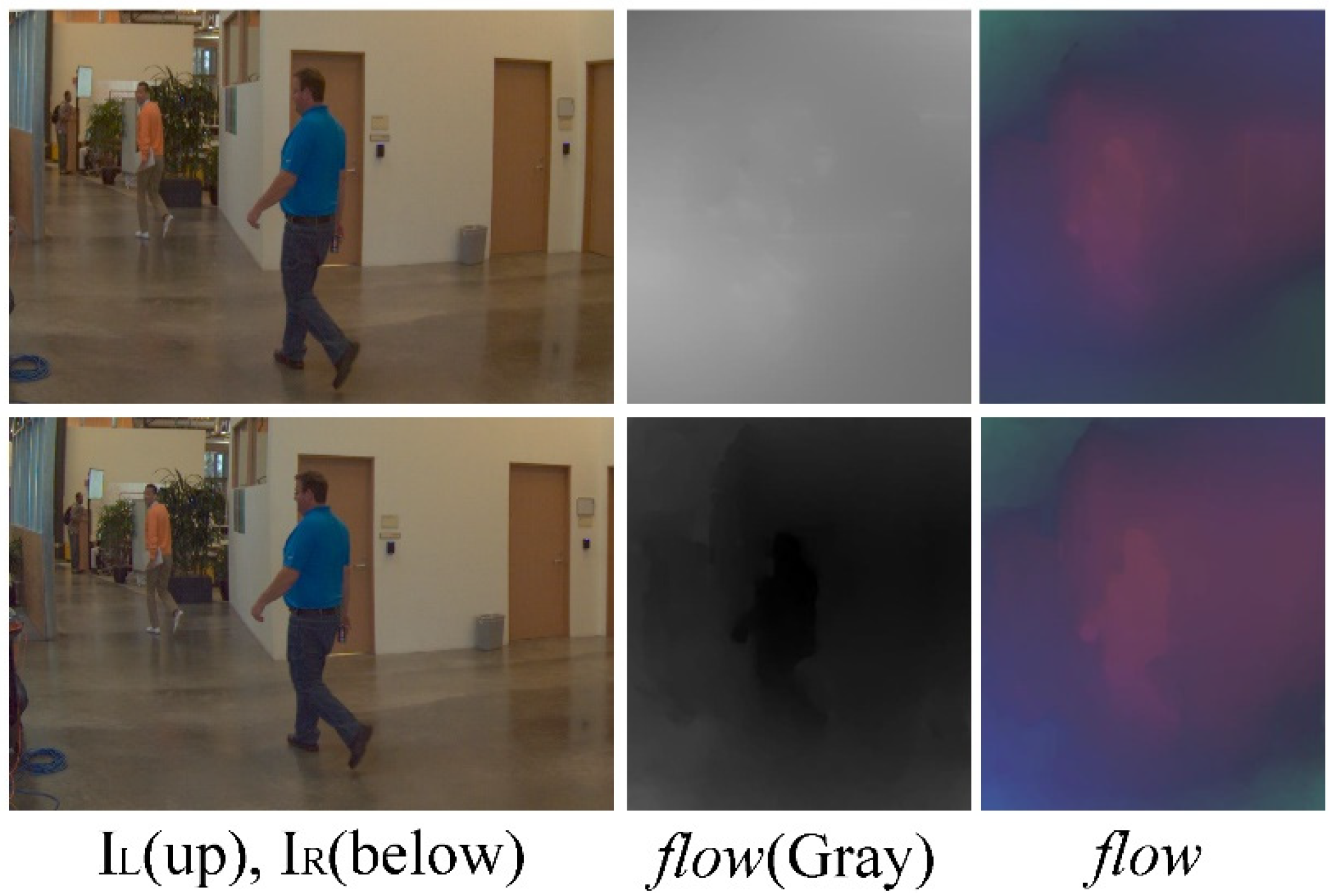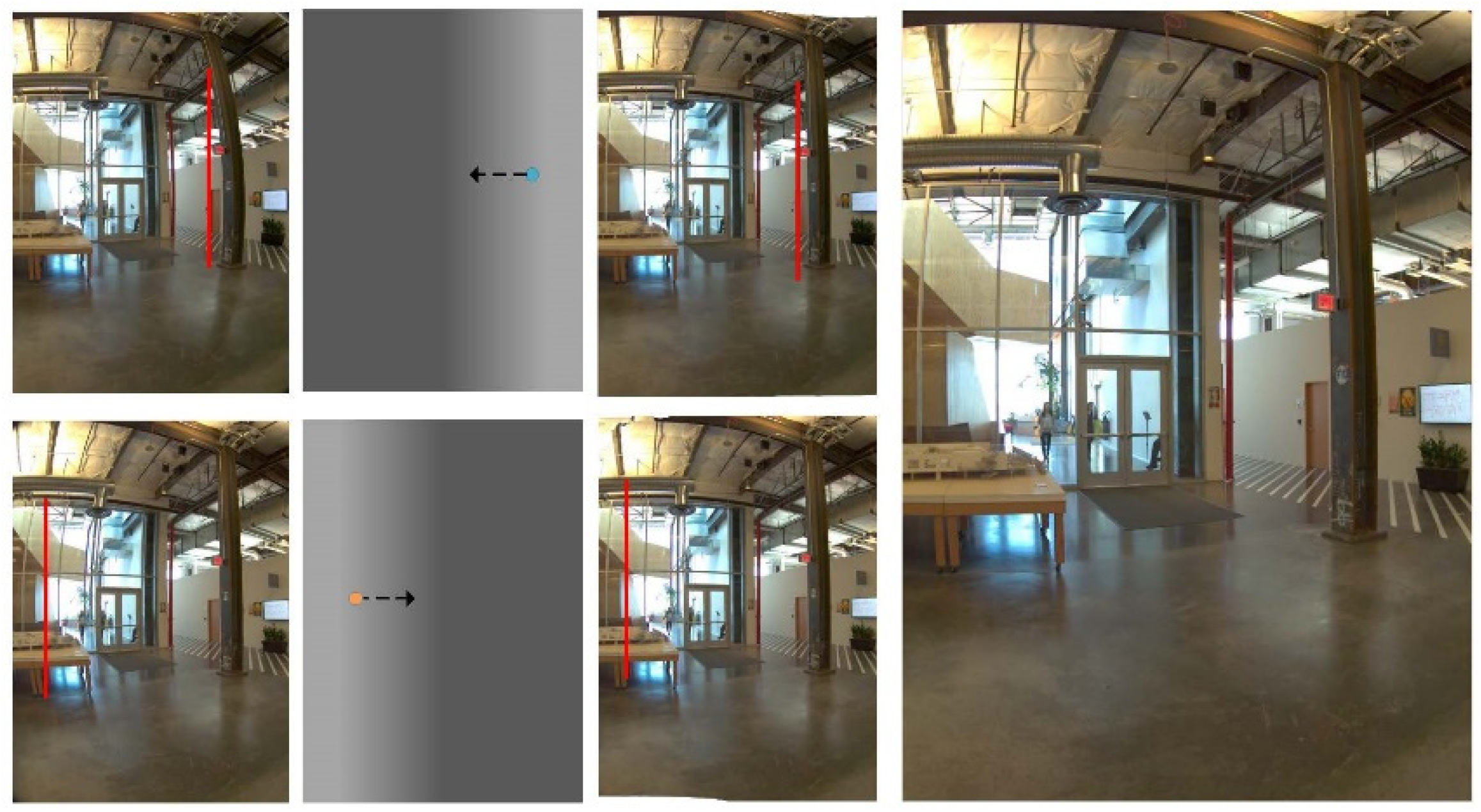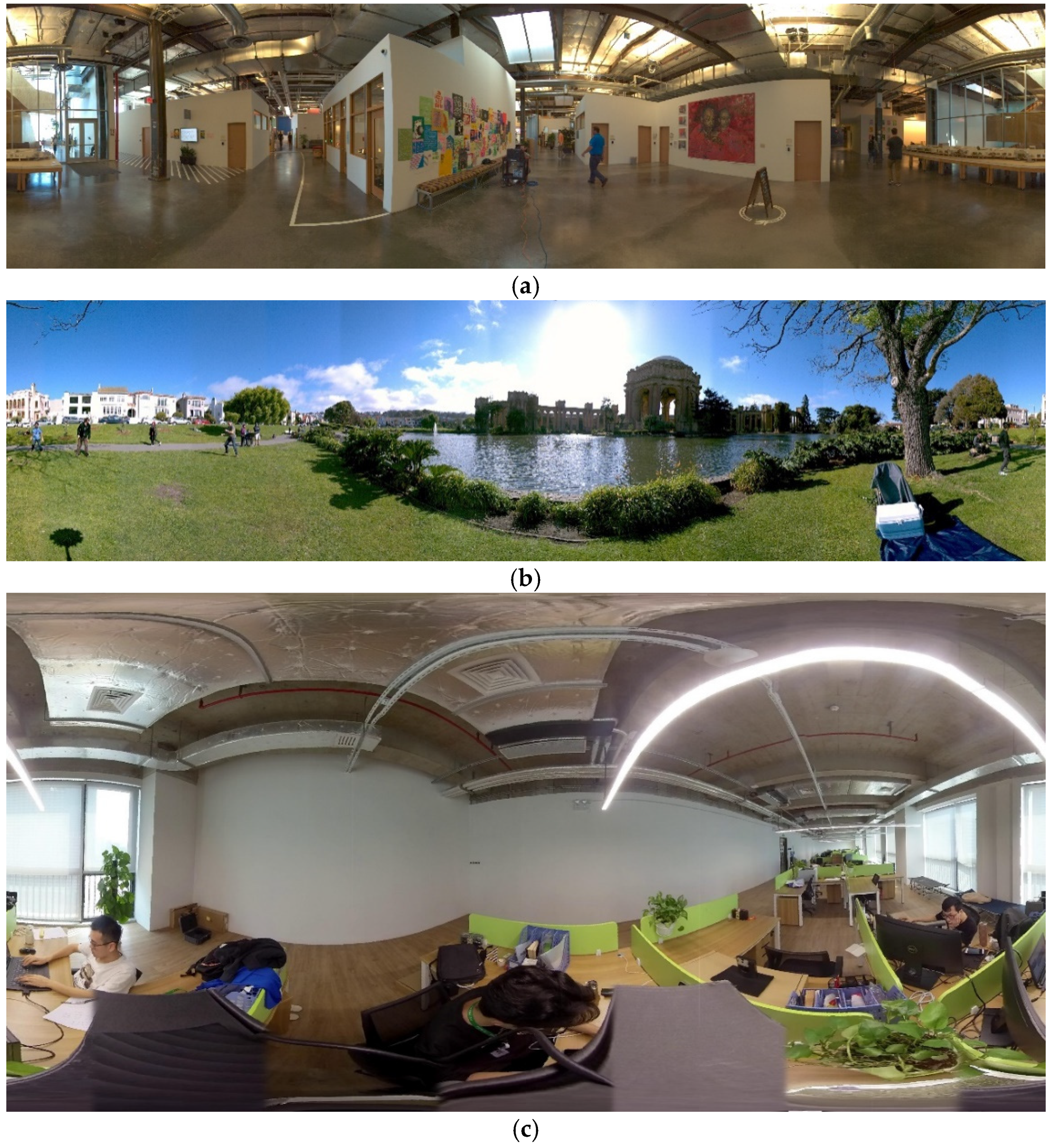Generating High-Quality Panorama by View Synthesis Based on Optical Flow Estimation
Abstract
:1. Introduction
2. Related Work
2.1. Panorama Stitching
2.2. Image-Based Rendering
3. The Proposed Method
3.1. System Overview
3.2. Optical Flow Estimation
| Algorithm 1. Calculate the optical flow field. |
| Input:,—the grayscale images of the left and the right views ,—the alpha maps of the left and the right views ,,,—gradients in two directions ,—the flow and its gaussian blur version Output: —the final optical flow field
|
3.3. Reconstructed View-Based Blending Algorithm
4. Experimental Results
4.1. Datasets
4.2. Ablation Study
4.3. Viewing and Analysis
5. Conclusions
Author Contributions
Funding
Institutional Review Board Statement
Informed Consent Statement
Data Availability Statement
Conflicts of Interest
References
- Brown, M.; Lowe, D.G. Automatic Panoramic Image Stitching using Invariant Features. Int. J. Comput. Vis. 2007, 74, 59–73. [Google Scholar] [CrossRef] [Green Version]
- Zaragoza, J.; Chin, T.-J.; Brown, M.S.; Suter, D. As-projective-as-possible image stitching with moving dlt. In Proceedings of the IEEE Conference on Computer Vision and Pattern Recognition, Portland, OR, USA, 23–28 June 2013; pp. 2339–2346. [Google Scholar]
- Chang, C.-H.; Sato, Y.; Chuang, Y.-Y. Shape preserving half-projective warps for image stitching. In Proceedings of the IEEE Conference on Computer Vision and Pattern Recognition, Columbus, OH, USA, 23–28 June 2014; pp. 3254–3261. [Google Scholar]
- Lin, C.-C.; Pankanti, S.U.; Ramamurthy, K.N.; Aravkin, A.Y. Adaptive as-natural-as-possible image stitching. In Proceedings of the IEEE Conference on Computer Vision and Pattern Recognition, Boston, MA, USA, 7–12 June 2015; pp. 1155–1163. [Google Scholar]
- Lin, K.; Jiang, N.; Cheong, L.-F.; Do, M.; Lu, J. Seagull: Seam-guided local alignment for parallax-tolerant image stitching. In Proceedings of the European Conference on Computer Vision, Amsterdam, The Netherlands, 11–14 October 2016; Springer: Berlin/Heidelberg, Germany, 2016; pp. 370–385. [Google Scholar]
- Thatte, J.; Girod, B. A statistical model for disocclusions in depth-based novel view synthesis. In Proceedings of the 2019 IEEE Visual Communications and Image Processing (VCIP), Sydney, Australia, 1–4 December 2019; pp. 1–4. [Google Scholar]
- Zhang, Y.; Zou, D.; Ren, J.S.; Jiang, Z.; Chen, X. Structure-preserving stereoscopic view synthesis with multi-scale adversarial correlation matching. In Proceedings of the 2019 IEEE/CVF Conference on Computer Vision and Pattern Recognition (CVPR), Long Beach, CA, USA, 15–20 June 2019; pp. 5853–5862. [Google Scholar]
- Bertel, T.; Campbell, N.D.F.; Richardt, C. MegaParallax: Casual 360° Panoramas with Motion Parallax. IEEE Trans. Vis. Comput. Graph. 2019, 25, 1828–1835. [Google Scholar] [CrossRef] [PubMed]
- Xu, B.; Jia, Y. Wide-angle image stitching using multihomography warping. In Proceedings of the 2017 IEEE International Conference on Image Processing (ICIP), Beijing, China, 17–20 September 2017; pp. 1467–1471. [Google Scholar]
- Chai, Q.; Liu, S. Shape-optimizing hybrid warping for image stitching. In Proceedings of the 2016 IEEE International Conference on Multimedia and Expo (ICME), Seattle, WA, USA, 11–15 June 2016; pp. 1–6. [Google Scholar]
- Fan, X.; Lei, J.; Fang, Y.; Huang, Q.; Ling, N.; Hou, C. Stereoscopic Image Stitching via Disparity-Constrained Warping and Blending. IEEE Trans. Multimed. 2019, 22, 655–665. [Google Scholar] [CrossRef]
- Richardt, C.; Pritch, Y.; Zimmer, H.; Sorkine-Hornung, A. Megastereo: Constructing high resolution stereo panoramas. In Proceedings of the IEEE Conference on Computer Vision and Pattern Recognition, Portland, OR, USA, 23–28 June 2013; pp. 1256–1263. [Google Scholar]
- Peleg, S.; Ben-Ezra, M.; Pritch, Y. Omnistereo: Panoramic stereo imaging. IEEE Trans. Pattern Anal. Mach. Intell. 2001, 23, 279–290. [Google Scholar] [CrossRef]
- Stankiewicz, O.; Wegner, K.; Tanimoto, M.; Doma’nski, M. Enhanced View Synthesis Reference Software (VSRS) for Free-VIEWPOINT Television. 2013. Available online: https://svn.multimedia.edu.pl/vsrs (accessed on 7 June 2021).
- Kalantari, N.K.; Wang, T.-C.; Ramamoorthi, R. Learning-based view synthesis for light field cameras. ACM Trans. Graph. 2016, 35, 1–10. [Google Scholar] [CrossRef] [Green Version]
- Chaurasia, G.; Duchene, S.; Sorkine-Hornung, O.; Drettakis, G. Depth synthesis and local warps for plausible image-based navigation. ACM Trans. Graph. 2013, 32, 1–12. [Google Scholar] [CrossRef]
- Zhou, T.; Tucker, R.; Flynn, J.; Fyffe, G.; Snavely, N. Stereo magnification: Learning view synthesis using multiplane images. ACM Trans. Graph. (TOG) 2018, 37, 1–12. [Google Scholar] [CrossRef] [Green Version]
- Flynn, J.; Neulander, I.; Philbin, J.; Snavely, N. Deepstereo: Learning to predict new views from the world’s imagery. In Proceedings of the IEEE Conference on Computer Vision and Pattern Recognition, Las Vegas, NV, USA, 27–30 June 2016; pp. 5515–5524. [Google Scholar]
- Kopf, J.; Cohen, M.F.; Szeliski, R. First-person hyper-lapse videos. ACM Trans. Graph. 2014, 33, 1–10. [Google Scholar] [CrossRef]
- Aliev, K.-A.; Sevastopolsky, A.; Kolos, M.; Ulyanov, D.; Lempitsky, V. Neural point-based graphics. In Computer Vision–ECCV 2020: 16th European Conference, Glasgow, UK, 23–28 August 2020; Springer: Berlin/Heidelberg, Germany, 2020; pp. 696–712. [Google Scholar]
- Thies, J.; Zollhöfer, M.; Nießner, M. Deferred neural rendering: Image synthesis using neural textures. ACM Trans. Graph. (TOG) 2019, 38, 1–12. [Google Scholar] [CrossRef]
- Sitzmann, V.; Thies, J.; Heide, F.; NieBner, M.; Wetzstein, G.; Zollhofer, M. Deepvoxels: Learning persistent 3d feature embeddings. In Proceedings of the IEEE/CVF Conference on Computer Vision and Pattern Recognition, Long Beach, CA, USA, 15–20 June 2019; pp. 2437–2446. [Google Scholar]
- Facebook. Surround360 System, Surround360 Website. 2019. Available online: https://github.com/facebook/Surround360 (accessed on 4 January 2022).
- Honauer, K.; Johannsen, O.; Kondermann, D.; Goldluecke, B. A dataset and evaluation methodology for depth estimation on 4d light fields. In Asian Conference on Computer Vision, Taipei, Taiwan, 20–24 November 2016; Springer: Berlin/Heidelberg, Germany, 2016; pp. 19–34. [Google Scholar]
- Scharstein, D.; Szeliski, R. High-accuracy stereo depth maps using structured light. In Proceedings of the 2003 IEEE Computer Society Conference on Computer Vision and Pattern Recognition, Madison, WI, USA, 18–20 June 2003; Volume 1, pp. 195–202. [Google Scholar]
- Geiger, A.; Lenz, P.; Urtasun, R. Are we ready for autonomous driving? The kitti vision benchmark suite. In Proceedings of the Conference on Computer Vision and Pattern Recognition (CVPR), Providence, RI, USA, 16–21 June 2012. [Google Scholar]
- Sandic-Stankovic, D.; Kukolj, D.; Le Callet, P. Dibr synthesized image quality assessment based on morphological pyramids. In Proceedings of the 2015 3DTV-Conference: The True Vision—Capture, Transmission and Display of 3D Video (3DTVCON), Lisbon, Portugal, 8–10 July 2015; pp. 1–4. [Google Scholar]









| Pipeline | MP-PSNR | PSNR | SSIM |
|---|---|---|---|
| w/o FE | 26.7732 | 21.5039 | 0.6301 |
| w/o FR | 24.6985 | 18.4631 | 0.5833 |
| w/o FB | 25.9854 | 18.7952 | 0.5711 |
| Ours | 28.0473 | 23.2075 | 0.7027 |
| Datasets/ Models | APAP [2] | AANAP [4] | SM [17] | Proposed | ||||||||
|---|---|---|---|---|---|---|---|---|---|---|---|---|
| MP-PSNR [27] | 25.0831 | 24.1017 | 24.1743 | 25.9847 | 24.1833 | 24.5380 | 27.1593 | 25.0037 | 24.0649 | 27.1482 | 25.1794 | 24.5882 |
| PSNR | 17.3444 | 20.1031 | 20.1295 | 18.8771 | 18.1437 | 18.1437 | 21.2529 | 19.5766 | 20.7835 | 21.0021 | 20.1295 | 21.2200 |
| SSIM | 0.4015 | 0.6100 | 0.6218 | 0.4275 | 0.6463 | 0.7078 | 0.4979 | 0.7167 | 0.5732 | 0.5518 | 0.7411 | 0.7914 |
Publisher’s Note: MDPI stays neutral with regard to jurisdictional claims in published maps and institutional affiliations. |
© 2022 by the authors. Licensee MDPI, Basel, Switzerland. This article is an open access article distributed under the terms and conditions of the Creative Commons Attribution (CC BY) license (https://creativecommons.org/licenses/by/4.0/).
Share and Cite
Zhang, W.; Wang, Y.; Liu, Y. Generating High-Quality Panorama by View Synthesis Based on Optical Flow Estimation. Sensors 2022, 22, 470. https://doi.org/10.3390/s22020470
Zhang W, Wang Y, Liu Y. Generating High-Quality Panorama by View Synthesis Based on Optical Flow Estimation. Sensors. 2022; 22(2):470. https://doi.org/10.3390/s22020470
Chicago/Turabian StyleZhang, Wenxin, Yumei Wang, and Yu Liu. 2022. "Generating High-Quality Panorama by View Synthesis Based on Optical Flow Estimation" Sensors 22, no. 2: 470. https://doi.org/10.3390/s22020470
APA StyleZhang, W., Wang, Y., & Liu, Y. (2022). Generating High-Quality Panorama by View Synthesis Based on Optical Flow Estimation. Sensors, 22(2), 470. https://doi.org/10.3390/s22020470





